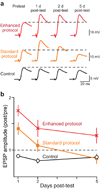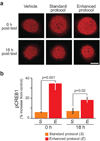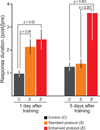Computational design of enhanced learning protocols
- PMID: 22197829
- PMCID: PMC3267874
- DOI: 10.1038/nn.2990
Computational design of enhanced learning protocols
Abstract
Learning and memory are influenced by the temporal pattern of training stimuli. However, the mechanisms that determine the effectiveness of a particular training protocol are not well understood. We tested the hypothesis that the efficacy of a protocol is determined in part by interactions among biochemical cascades that underlie learning and memory. Previous findings suggest that the protein kinase A (PKA) and extracellular signal-regulated kinase (ERK) cascades are necessary to induce long-term synaptic facilitation (LTF) in Aplysia, a neuronal correlate of memory. We developed a computational model of the PKA and ERK cascades and used it to identify a training protocol that maximized PKA and ERK interactions. In vitro studies confirmed that the protocol enhanced LTF. Moreover, the protocol enhanced the levels of phosphorylation of the transcription factor CREB1. Behavioral training confirmed that long-term memory also was enhanced by the protocol. These results illustrate the feasibility of using computational models to design training protocols that improve memory.
Figures




Comment in
-
A computational approach enhances learning in Aplysia.Nat Neurosci. 2012 Jan 26;15(2):178-9. doi: 10.1038/nn.3030. Nat Neurosci. 2012. PMID: 22281713 No abstract available.
Similar articles
-
Superior long-term synaptic memory induced by combining dual pharmacological activation of PKA and ERK with an enhanced training protocol.Learn Mem. 2017 Jun 15;24(7):289-297. doi: 10.1101/lm.044834.116. Print 2017 Jul. Learn Mem. 2017. PMID: 28620076 Free PMC article.
-
Rescue of impaired long-term facilitation at sensorimotor synapses of Aplysia following siRNA knockdown of CREB1.J Neurosci. 2015 Jan 28;35(4):1617-26. doi: 10.1523/JNEUROSCI.3330-14.2015. J Neurosci. 2015. PMID: 25632137 Free PMC article.
-
Doxorubicin attenuates serotonin-induced long-term synaptic facilitation by phosphorylation of p38 mitogen-activated protein kinase.J Neurosci. 2014 Oct 1;34(40):13289-300. doi: 10.1523/JNEUROSCI.0538-14.2014. J Neurosci. 2014. PMID: 25274809 Free PMC article.
-
Cellular, molecular, and epigenetic mechanisms in non-associative conditioning: implications for pain and memory.Neurobiol Learn Mem. 2013 Oct;105:133-50. doi: 10.1016/j.nlm.2013.06.008. Epub 2013 Jun 22. Neurobiol Learn Mem. 2013. PMID: 23796633 Free PMC article. Review.
-
Multiple serotonergic mechanisms contributing to sensitization in aplysia: evidence of diverse serotonin receptor subtypes.Learn Mem. 2003 Sep-Oct;10(5):373-86. doi: 10.1101/lm.66103. Learn Mem. 2003. PMID: 14557610 Free PMC article. Review.
Cited by
-
Effect of circadian phase on memory acquisition and recall: operant conditioning vs. classical conditioning.PLoS One. 2013;8(3):e58693. doi: 10.1371/journal.pone.0058693. Epub 2013 Mar 22. PLoS One. 2013. PMID: 23533587 Free PMC article.
-
Enhancing Associative Learning in Rats With a Computationally Designed Training Protocol.Biol Psychiatry Glob Open Sci. 2023 Aug 1;4(1):165-181. doi: 10.1016/j.bpsgos.2023.07.006. eCollection 2024 Jan. Biol Psychiatry Glob Open Sci. 2023. PMID: 38298784 Free PMC article.
-
Role of p90 ribosomal S6 kinase in long-term synaptic facilitation and enhanced neuronal excitability.Sci Rep. 2020 Jan 17;10(1):608. doi: 10.1038/s41598-020-57484-y. Sci Rep. 2020. PMID: 31953461 Free PMC article.
-
The Contribution of Spatial and Temporal Molecular Networks in the Induction of Long-term Memory and Its Underlying Synaptic Plasticity.AIMS Neurosci. 2016;3(3):356-384. doi: 10.3934/Neuroscience.2016.3.356. Epub 2016 Oct 22. AIMS Neurosci. 2016. PMID: 27819030 Free PMC article.
-
Nicotine shifts the temporal activation of hippocampal protein kinase A and extracellular signal-regulated kinase 1/2 to enhance long-term, but not short-term, hippocampus-dependent memory.Neurobiol Learn Mem. 2014 Mar;109:151-9. doi: 10.1016/j.nlm.2014.01.009. Epub 2014 Jan 21. Neurobiol Learn Mem. 2014. PMID: 24457151 Free PMC article.
References
-
- Cepeda NJ, Pashler H, Vul E, Wixted JT, Rohrer D. Distributed practice in verbal recall tasks: a review and quantitative synthesis. Psychol. Bull. 2006;132:354–380. - PubMed
-
- Smolen P, Baxter DA, Byrne JH. Frequency selectivity, multistability, and oscillations emerge from models of genetic regulatory systems. Am. J. Physiol. 1998;274:531–542. - PubMed
-
- Byrne JH, et al. Learning and memory: basic mechanisms. In: Byrne JH, Roberts JL, editors. From Molecules to Networks: An Introduction to Cellular and Molecular Neuroscience 2nd edn. Elsevier; 2009. pp. 539–608.
Publication types
MeSH terms
Substances
Grants and funding
LinkOut - more resources
Full Text Sources
Other Literature Sources
Miscellaneous

